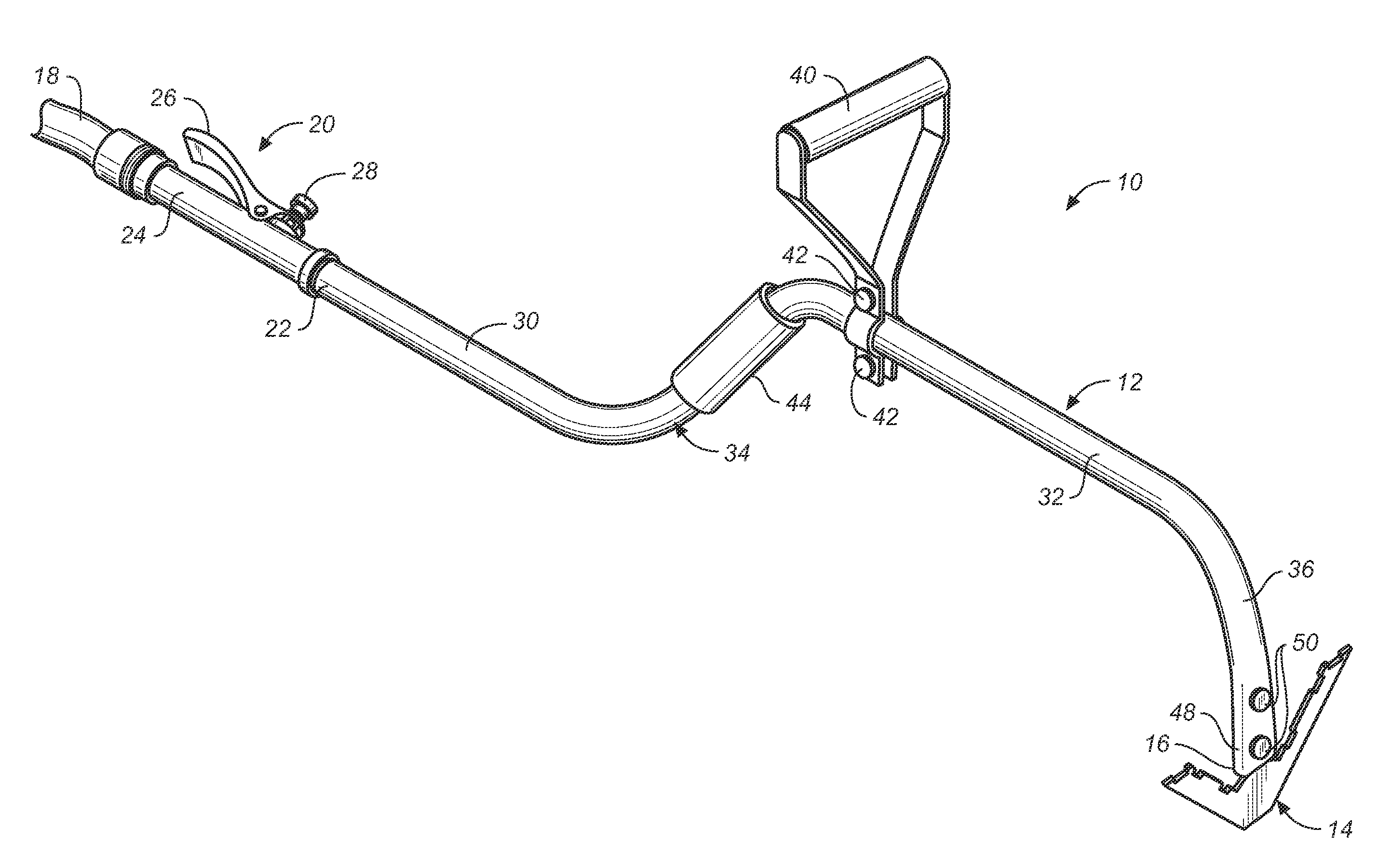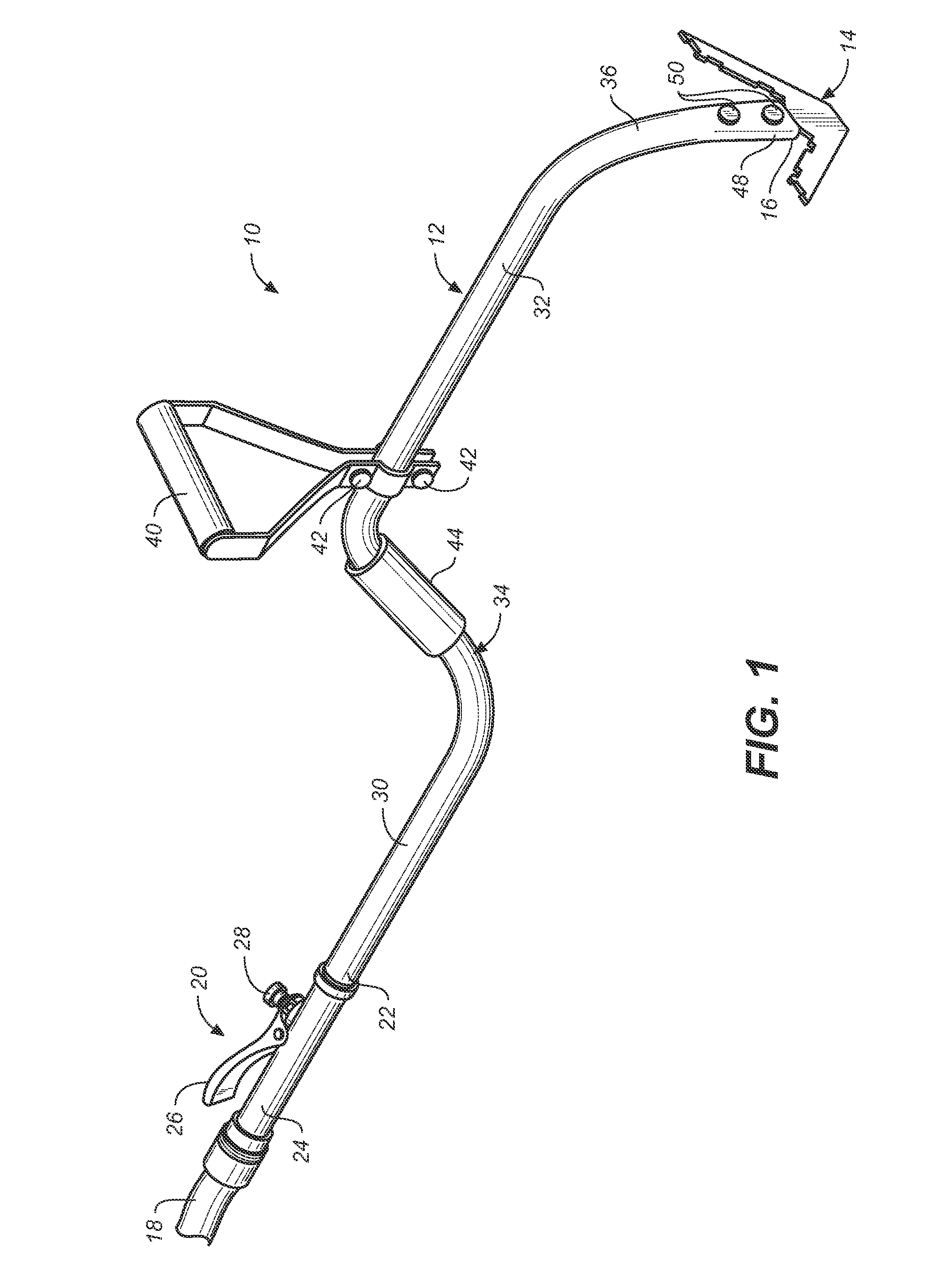Mixing blade for cementitious material
a technology of cementitious materials and tools, which is applied in the direction of mixing, mixing, chemistry apparatus and processes, etc., can solve the problems of not working well to thoroughly mix dry cementitious materials, not having the same area as a conventional hoe, and not being able to achieve satisfactory mixing of concrete and other dry cementitious materials with water. achieve the effect of more thorough, uniform and efficient mixing
- Summary
- Abstract
- Description
- Claims
- Application Information
AI Technical Summary
Benefits of technology
Problems solved by technology
Method used
Image
Examples
first embodiment
[0019]FIGS. 1-4 illustrate a mixing blade 14 in accordance with the invention. As shown best in FIGS. 2, 3 and 4, blade 14 is rigid V-shaped planar member having a central bottom blade section 60 from which tang 52 extends, a straight bottom edge 62, and a pair of legs 64, 66, respectively, extending outwardly and upwardly at inclined angles from the central blade section 60 and the bottom edge 62 of the blade to impart a V-shape to the blade. Tang 52 may bisect the legs and extend upwardly from the central section of the member about a central axis of the blade for connection to the handle of tool 10. Each of the legs 64, 66 of the blade may have an outer lateral edge 70 extending upwardly from bottom edge 62, an interior lateral edge 72 parallel to the outer lateral edge 70, and a top edge 74 that extends between the outer and interior lateral edges of each leg, is generally parallel to bottom edge 62, and is normal to the tang 52 and the central axis of the blade. The interior la...
second embodiment
[0023]FIG. 5 illustrates a blade 100 in accordance with the invention that may be used with tool 10. As shown, blade 100 comprises a triangularly shaped blade member having lateral side edges 102, 104 which slope upwardly from a straight bottom edge 106, a top edge 108 and a central triangularly shaped cut-out or opening 110 through the blade that preferably matches the triangular shape of the blade. The straight bottom edge truncates the triangular shape of the blade at the tip region. Opening 110 may be sized to form a pair of side legs 112, 114 that are generally similar in size and shape to legs 64 and 66 of V-shaped blade 14, and that are upwardly inclined at an angle from a bottom portion 116 of the blade 100. A top member 118 may extend between upper ends of the legs 112 and 114. The top member 118 may be formed with one or more notches or cut-outs 120 in its top edge 108. The blade 100 thus has a generally triangular open frame shape. The cut-outs may be similar to the cut-o...
third embodiment
[0026]FIG. 6 illustrates a multi-purpose mixing blade 200 in accordance with the invention that may be used with tool 10. Blade 200 may be substantially the same as blade 100 of FIG. 5, comprising a triangularly-shaped blade having a triangularly-shaped central opening 202, except that blade 200 has cut-outs 204 formed in the interior edges 206 of lateral side legs 208 and 210 within the central triangularly-shaped opening 202. As with blade 100, blade 200 may have cut-outs 216 formed in a top edge 220 of the blade.
[0027]Blade 200 functions in a similar way to that described for blades 14 and 100. Cut-outs 204 and 216 function as previously described to provide edges for spinning gravel in concrete mix, and the central opening 202 in the blade is effective for mixing other types of materials such as mortar and grout, as described above for blade 100.
[0028]Blades 100 and 200 of FIGS. 5 and 6, respectively, may be formed in a similar manner to that described for blade 14, preferably b...
PUM
 Login to View More
Login to View More Abstract
Description
Claims
Application Information
 Login to View More
Login to View More - R&D
- Intellectual Property
- Life Sciences
- Materials
- Tech Scout
- Unparalleled Data Quality
- Higher Quality Content
- 60% Fewer Hallucinations
Browse by: Latest US Patents, China's latest patents, Technical Efficacy Thesaurus, Application Domain, Technology Topic, Popular Technical Reports.
© 2025 PatSnap. All rights reserved.Legal|Privacy policy|Modern Slavery Act Transparency Statement|Sitemap|About US| Contact US: help@patsnap.com



